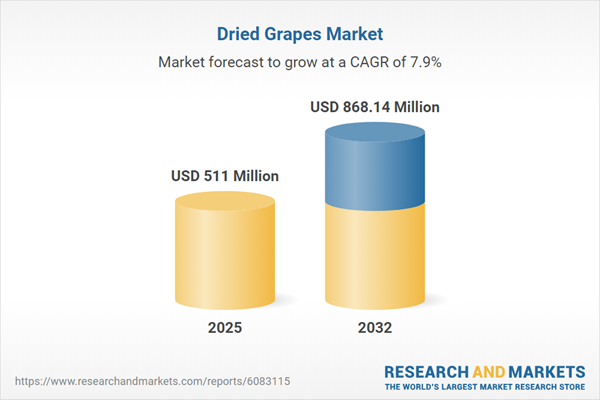Speak directly to the analyst to clarify any post sales queries you may have.
The global dried grapes market is adapting rapidly as consumer preferences shift towards health-focused snacking and clean-label products. Senior decision-makers must monitor emerging innovations, evolving regulations, and sustainability imperatives that are shaping industry growth and competitive positioning.
Market Snapshot: Dried Grapes Market Size and Growth Trends
The Dried Grapes Market grew from USD 473.64 million in 2024 to USD 511 million in 2025. It is expected to continue growing at a CAGR of 7.86%, reaching USD 868.14 million by 2032. This robust expansion highlights surging demand across key regions due to consumer prioritization of nutritional snacks, improved supply chain efficiency, and the adoption of advanced dehydration and packaging technologies.
Scope & Segmentation
The research offers a comprehensive segmentation of the dried grapes market, analyzing demand drivers and developments across the following dimensions:
- Product Types: Currants, Sultana Raisins, Thompson Raisins
- Forms: Whole, Pieces
- Packaging Types: Box, Bulk, Pouch
- Distribution Channels: Convenience Stores, Online Retail (Mobile App, Website), Specialty Stores, Supermarkets & Hypermarkets
- End Users: Food Processing (Bakery, Confectionery, Snacks), Retail
- Regions: Americas (United States, Canada, Mexico, Brazil, Argentina, Chile, Colombia, Peru), Europe, Middle East & Africa (United Kingdom, Germany, France, Russia, Italy, Spain, Netherlands, Sweden, Poland, Switzerland, United Arab Emirates, Saudi Arabia, Qatar, Turkey, Israel, South Africa, Nigeria, Egypt, Kenya), Asia-Pacific (China, India, Japan, Australia, South Korea, Indonesia, Thailand, Malaysia, Singapore, Taiwan)
- Leading Companies: Sunsweet Growers Inc., Mariani Packing Company, Olam International Limited, Del Monte Pacific Limited, National Raisin Company LLC, Stahmann Farms, Inc., AgroAmerica, Inc., Raisin Valley Farms, LLC
- Key Technologies: Infrared and microwave-assisted dehydration, solar hybrid tunnels, blockchain-based traceability, compostable and resealable packaging, precision irrigation, and non-GMO cultivation.
Key Takeaways for Decision-Makers
- Rising health consciousness and interest in functional foods have positioned dried grapes as a versatile ingredient and favored snack, accelerating market diversification and premiumization.
- Sustainability is now a differentiator; initiatives like precision irrigation, renewable energy, and compostable packaging draw positive attention from partners and end users.
- Advanced dehydration methods and supply chain traceability deliver higher quality, extended shelf life, and elevated consumer trust, supporting robust demand in both retail and food processing channels.
- Flavor-infused and organic-certified product lines enable targeted positioning for gourmet, vegan, and clean-label market segments without compromising operational efficiency.
- Digital transformation—spanning e-commerce, personalized promotions, and analytics—is increasing brand engagement and facilitating faster response to consumer trends and regulatory shifts.
Tariff Impact and Trade Realignment
Recent United States tariffs on select dried fruit imports have prompted global stakeholders to reevaluate sourcing strategies. The added cost burden has encouraged importers to pursue alternative logistics routes and renegotiate supplier arrangements. Domestic producers have seen a boost in demand, while smaller players are exploring collaborative models to maximize scale and minimize trade disruption. The sector’s resilience is demonstrated through diversified procurement and adaptive risk management frameworks, ensuring continuity within a dynamic trade landscape.
Methodology & Data Sources
This report utilizes a dual-method research framework, synthesizing primary interviews with growers, processors, distributors, and buyers, alongside field visits and secondary analysis from reputable publications. Cross-validation and data triangulation support robust insight, while expert workshops align conclusions with current industry standards and challenges.
Why This Dried Grapes Market Report Matters
- Enables informed, tactical decision-making by providing a holistic view of evolving product, technology, and channel strategies across global dried grapes markets.
- Supports risk mitigation with early insights into trade policy impacts, regulatory developments, and emerging sustainability innovations.
- Facilitates stakeholder alignment through in-depth segmentation and actionable intelligence for product development, sourcing, and digital transformation initiatives.
Conclusion
Dried grapes markets are evolving in response to health-driven consumer demand, technological advances, and the pressure for sustainable supply chains. Senior leaders can leverage this analysis to anticipate opportunities, address risks, and strengthen competitive positioning across regions and channels.
Table of Contents
3. Executive Summary
4. Market Overview
7. Cumulative Impact of Artificial Intelligence 2025
Companies Mentioned
The companies profiled in this Dried Grapes market report include:- Sunsweet Growers Inc.
- Mariani Packing Company
- Olam International Limited
- Del Monte Pacific Limited
- National Raisin Company LLC
- Stahmann Farms, Inc.
- AgroAmerica, Inc.
- Raisin Valley Farms, LLC
Table Information
| Report Attribute | Details |
|---|---|
| No. of Pages | 180 |
| Published | October 2025 |
| Forecast Period | 2025 - 2032 |
| Estimated Market Value ( USD | $ 511 Million |
| Forecasted Market Value ( USD | $ 868.14 Million |
| Compound Annual Growth Rate | 7.8% |
| Regions Covered | Global |
| No. of Companies Mentioned | 9 |









